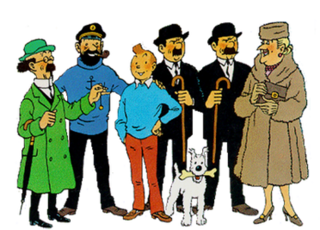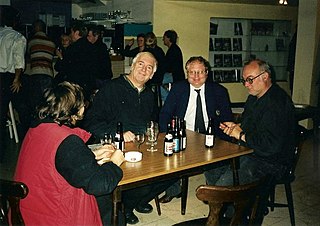
A comic book or comicbook, also called comic magazine or simply comic, is a publication that consists of comics art in the form of sequential juxtaposed panels that represent individual scenes. Panels are often accompanied by descriptive prose and written narrative, usually, dialog contained in word balloons emblematic of the comics art form. Although comics has some origins in 18th century Japan, comic books were first popularized in the United States and the United Kingdom during the 1930s. The first modern comic book, Famous Funnies, was released in the U.S. in 1933 and was a reprinting of earlier newspaper humor comic strips, which had established many of the story-telling devices used in comics. The term comic book derives from American comic books once being a compilation of comic strips of a humorous tone; however, this practice was replaced by featuring stories of all genres, usually not humorous in tone.

The Silver Age of Comic Books was a period of artistic advancement and widespread commercial success in mainstream American comic books, predominantly those featuring the superhero archetype. Following the Golden Age of Comic Books and an interregnum in the early to mid-1950s, the Silver Age is considered to cover the period from 1956 to circa 1970, and was succeeded by the Bronze and Modern Ages.
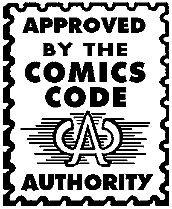
The Comics Code Authority (CCA) was formed in 1954 by the Comics Magazine Association of America as an alternative to government regulation, to allow the comic publishers to self-regulate the content of comic books in the United States. The code was voluntary, there was no law requiring its use. Its code, commonly called "the Comics Code", lasted until the early 21st century. The CCA formation followed a series of Senate hearings and the publication of psychiatrist Fredric Wertham's book Seduction of the Innocent.
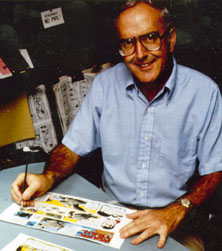
A cartoonist is a visual artist who specializes in drawing cartoons. This work is often created for entertainment, political commentary, or advertising. Cartoonists may work in many formats, such as booklets, comic strips, comic books, editorial cartoons, graphic novels, manuals, gag cartoons, graphic design, illustrations, storyboards, posters, shirts, books, advertisements, greeting cards, magazines, newspapers, and video game packaging.

The Phantom is an American adventure comic strip, first published by Lee Falk in February 1936. The main character, the Phantom, is a fictional costumed crime-fighter who operates from the fictional African country of Bangalla. The character has been adapted for television, film and video games.
Joseph Leo Baxendale was an English cartoonist and publisher. Baxendale wrote and drew several titles. Among his best known creations are the Beano strips Little Plum, Minnie the Minx, The Bash Street Kids, and The Three Bears.
Image Comics is an American comic book publisher and is the third largest comic book and graphic novel publisher in the industry in both unit and market share. It was founded in 1992 by several high-profile illustrators as a venue for creator-owned properties, in which comics creators could publish material of their own creation without giving up the copyrights to those properties, as is normally the case in the work for hire-dominated American comics industry, in which the legal author is a publisher, such as Marvel Comics or DC Comics, and the creator is an employee of that publisher. Its output was originally dominated by superhero and fantasy series from the studios of the founding Image partners, but now includes comics in many genres by numerous independent creators. Its best-known publications include The Walking Dead, Spawn, Savage Dragon, Witchblade, The Darkness, Invincible, Saga, Chew, Bone, Deadly Class, I Kill Giants, Hit-Girl, Kick-Ass, Kingsman: The Secret Service, Monstress, Snotgirl, Bitch Planet, Criminal, The Wicked + The Divine, Outcast By Kirkman & Azaceta, Descender, Wytches, and more.
A letterer is a member of a team of comic book creators responsible for drawing the comic book's text. The letterer's use of typefaces, calligraphy, letter size, and layout all contribute to the impact of the comic. The letterer crafts the comic's "display lettering": the story title lettering and other special captions and credits that usually appear on a story's first page. The letterer also writes the letters in the word balloons and draws in sound effects. Many letterers also design logos for the comic book company's various titles.
An ashcan copy is a type of American comic book originally created solely to establish trademarks on potential titles and not intended for sale. The practice was common in the 1930s and 1940s when the comic book industry was in its infancy, but was phased out after updates to US trademark law. The term was revived in the 1980s by Bob Burden, who applied it to prototypes of his self-published comic book. Since the 1990s, the term has been used to describe promotional materials produced in large print runs and made available for mass consumption. In the film and television industries, the term has been adopted for low-grade material created to preserve a claim to licensed property rights.

A comics artist is a person working within the comics medium on comic strips, comic books, or graphic novels. The term may refer to any number of artists who contribute to produce a work in the comics form, from those who oversee all aspects of the work to those who contribute only a part.

Funnies, Inc. is an American comic book packager of the 1930s to 1940s period collectors and historians call the Golden Age of Comic Books. Founded by Lloyd Jacquet, it supplied the contents of early comics, including that of Marvel Comics #1, the first publication of what would become the multimedia corporation Marvel Comics.
Darryl Banks is an American comic book artist. He worked on one of the first painted comic books, Cyberpunk, and teamed with the writer Mark Ellis to revamp the long-running The Justice Machine series for two publishers, Innovation and Millennium.
Leonard Brandt Cole was a comic book artist, editor, and publisher who worked during the Golden Age of Comic Books, producing work in various genres. Cole was particularly known for his bold covers, featuring what he referred to as "poster colors"—the use of primary colors often over black backgrounds. In addition to his covers, Cole did interior art for comics published by Holyoke Publications, Gilberton, and Ajax/Farrell. He also worked as an editor for Holyoke in the 1940s.
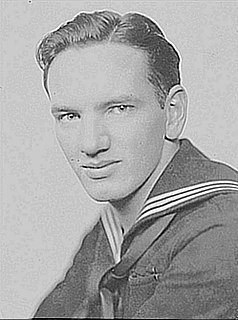
Joseph P. Gill was an American magazine writer and highly prolific comic book scripter. Most of his work was for Charlton Comics, where he co-created the superheroes Captain Atom, Peacemaker, and Judomaster, among others. Comics historians consider Gill a top contender as the comic-book field's most prolific writer. Per historian and columnist Mark Evanier, Gill "wrote a staggering number of comics. There are a half-dozen guys in his category. If someone came back and said he was the most prolific ever, no one would be surprised."

Dan DiDio is an American writer, editor, and publisher who has worked in the television and comic book industries. He is currently the co–publisher of DC Comics, along with Jim Lee. Wizard magazine recognized him as its first ever "Man of the Year" in 2003 for his work in the DC Universe line of comics.

Crime comics is a genre of American comic books and format of crime fiction. The genre was originally popular in the late 1940s and early 1950s and is marked by a moralistic editorial tone and graphic depictions of violence and criminal activity. Crime comics began in 1942 with the publication of Crime Does Not Pay published by Lev Gleason Publications and edited by Charles Biro. As sales for superhero comic books declined in the years after World War II, other publishers began to emulate the popular format, content and subject matter of Crime Does Not Pay, leading to a deluge of crime-themed comics. Crime and horror comics, especially those published by EC Comics, came under official scrutiny in the late 1940s and early 1950s, leading to legislation in Canada and Great Britain, the creation in the United States of the Comics Magazine Association of America and the imposition of the Comics Code Authority in 1954. This code placed limits on the degree and kind of criminal activity that could be depicted in American comic books, effectively sounding the death knell for crime comics and their adult themes.
José María Massaroli is an Argentine comic artist, born in the Ramallo Partido, Buenos Aires Province.

Blue Bolt is a fictional American comic book superhero created by writer-artist Joe Simon in 1940, during the period fans and historians refer to as the Golden Age of Comic Books.
Another Rainbow Publishing is a company dedicated to the re-publication and greater recognition of the work of Carl Barks that was created in 1981 by Bruce Hamilton and Russ Cochran. Its name references Barks's saying that there would be "always another rainbow" for his character Scrooge McDuck, which also became the title of one of Barks's oil paintings of the richest duck in the world. Its subsidiary division "Gladstone Publishing", founded in 1985, for non-Barks Disney comics several times throughout the 1980s and 1990s became the major to only publisher of Disney comics in the USA.

Archie is a long-running comic strip based on the line of the popular Archie Comics. Launched by McClure Newspaper Syndicate in 1947, it features the misadventures of Archie Andrews and his pals. Archie is currently distributed by the Creators Syndicate.



